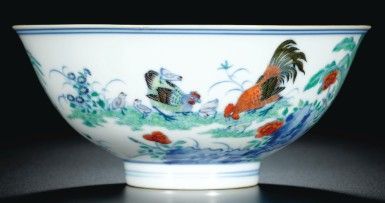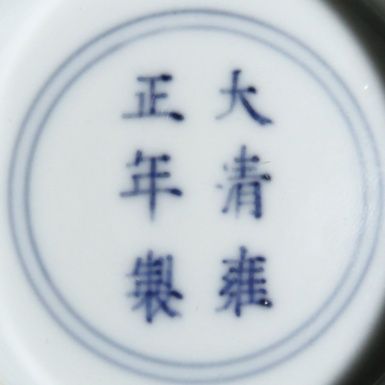A Fine And Rare Doucai 'Chicken' Bowl Mark And Period Of Yongzheng - Sotheby's
A Fine and Rare Doucai 'Chicken' Bowl. Mark and Period of Yongzheng - Photo Sotheby's
the deep rounded sides rising from a slightly tapered foot to a gently flared rim, brightly painted in delicate shades of enamels and underglaze blue with an exterior scene depicting two cockerels with red hackle and black feathers, each accompanied by a yellow hen and their four or five chicks coloured aubergine or yellow, standing or bending down searching for food in a meadow, the continuous landscape interrupted by two large rock formations issuing foliate sprays of iron-red roses and blue-petalled asters, with a lush plantain tree on one side and two windmill palms on the other, all between double blue lines at the rim and foot, the interior similarly decorated with a medallion of a red cockerel and a yellow hen perching on rocks, among sprays of asters and roses below a plantain tree, the base inscribed with a six-character mark within double circles in underglaze blue; 15.4 cm., 6 1/8 in. Estimation: 3,000,000 - 5,000,000 HKD
NOTE DE CATALOGUE: In its subject the present bowl is based on a Chenghua prototype found on smaller cups; however the treatment of the design reveals a complete Yongzheng reinterpretation of the original. While the broader proportions of the bowl provide a larger canvas on which to reformat the scene, the quiet intimate mood of the Chenghua version has been substituted for one that is more dramatically conceived. The craftsman has supplemented the garden setting with further plants, including aster flowers, papyrus and plantain trees to harmoniously fill the broad area of space while leading the eye around the bowl through the selective use of bold red and black enamel. The elegant yet naturalistic depiction of plants, roosters and hens, with their fuller tails and proud poses that appear to occupy their garden spacerather than float within it, reflect the elegant style of the Yongzheng period.
A closely related example in the Chang Foundation, Taipei, is illustrated in Selected Chinese Ceramics from Han to Qing Dynasties, Taipei, 1990, pl. 139; a pair of bowls in the Umezawa Kinenkan Museum, Tokyo, was included in the exhibition Shincho toji, MOA Museum of Art, Atami, 1984, cat. no. 38; another pair was sold at Christie’s London, 12th May 2009, lot 166; and a single bowl was sold in our London rooms, 12th July 1966, lot 311, again in our New York rooms, 1st June 1988, lot 172, and a third time at Christie’s Hong Kong, 30th October 1995, lot 748. For Chenghua ‘chicken’ cups, see two in the National Palace Museum, Taipei, included in the Museum’s exhibition Ming Chenghua ciqi tezhan, 1976, cat. nos. 1 and 29; further two in the Palace Museum, Beijing, published in Toji taikei, vol. 43, Tokyo, 1973, p. 94, figs. 15 and 16; and one from the collection of Edward T. Chow, sold in these rooms, 19th May 1981, lot 429, and now in the collection of Au Bak Ling.
Although the subject of a cock and hen with chicks in a garden is known from paintings of the Song dynasty it was first encountered on porcelain during the Chenghua period. The renewed interest in ‘chicken’ paintings may be connected with the thoughts of the philosopher Chen Baisha who is known to have been summoned to the court by the Chenghua emperor. Chen’s teaching of an optimistic pragmatism nurtured by simplicity, sincerity and gratefulness for life seems well illustrated by the rustic scene of chickens and chicks and would have appealed to the Qing emperors.
Doucai decoration, whereby the motif is outlined in blue under the glaze and coloured over the glaze with enamels within the blue line, is derived from the cloisonné technique of the Ming period. The technique of producing doucai wares was developed in the Chenghua period (1426-35) as can be seen from the wonderful Chenghua ‘chicken’ cups and stembowls. Doucai wares continued to be appreciated for their understated elegance and for their association with Chenghua porcelain during the Qing dynasty and were particularly favoured by the Yongzheng and Qianlong emperors.
Sotheby's. Fine Chinese Ceramics & Works of Art. Hong Kong | 09 oct. 2012 www.sothebys.com

/https%3A%2F%2Fprofilepics.canalblog.com%2Fprofilepics%2F1%2F0%2F100183.jpg)
/https%3A%2F%2Fstorage.canalblog.com%2F03%2F02%2F119589%2F96711876_o.jpg)
/https%3A%2F%2Fstorage.canalblog.com%2F11%2F31%2F119589%2F94773502_o.jpg)
/https%3A%2F%2Fstorage.canalblog.com%2F20%2F83%2F119589%2F94772815_o.jpg)
/https%3A%2F%2Fstorage.canalblog.com%2F26%2F72%2F119589%2F75604929_o.jpg)
/https%3A%2F%2Fstorage.canalblog.com%2F59%2F60%2F119589%2F26458628_o.jpg)






/image%2F1371349%2F20240326%2Fob_936d86_104-1.jpg)
/image%2F1371349%2F20240326%2Fob_823710_102-1.jpg)
/image%2F1371349%2F20240326%2Fob_55a293_101-1.jpg)
/http%3A%2F%2Fstorage.canalblog.com%2F33%2F99%2F119589%2F129627838_o.jpg)